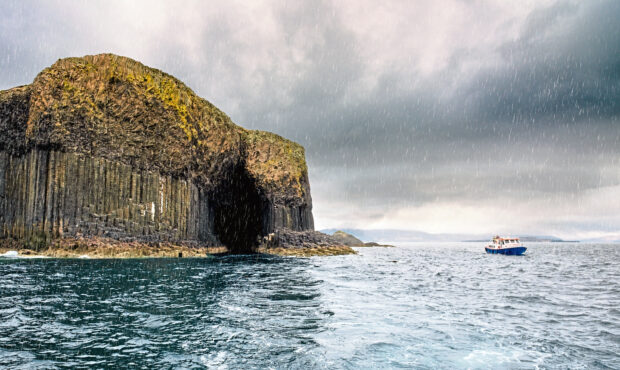
Stories of giants can be found in both Scotland and Ireland – in mythology and in the names of the land itself.
The island of Staffa, in the Inner Hebrides in Scotland, has the same strange geometric rock formations as the Giant’s Causeway in Northern Ireland, and it is thought the two were once connected by an ancient lava flow.
If legends are to be believed, however, the two are all that remains of a bridge built by giants. The Irish warrior, Fionn mac Cumhaill, challenged the Scottish giant Benandonner to a duel, and built the bridge so the giant could reach him.
When Benandonner came charging across the bridge, Fionn realised he could never win against him and hid in a cradle, disguised as a baby.
Benandonner found the cradle, remarked on the baby’s size – and ran back across the bridge in fear of how big the father must be. As he ran he smashed the bridge into the sea so Fionn couldn’t follow. All that remains are the two strange rock formations on either side of the Irish Sea.
Another legend says a colossal giant once lived in Trotternish Ridge on the Isle of Skye. His family buried him on the ridge when he died, but left his thumb sticking out of the ground as a marker – creating the Old Man of Storr.
Many countries have tales of giants, of course, but Scotland also has one giant on record.
Angus MacAskill was the tallest person, at 2.36 metres (7ft 9in) in 1847. His record remained unbroken until 1940 when Robert Wadlow, Illinois, was found to be 2.7m (8ft 11in).
Angus is claimed by two countries – Scotland, where he was born on the Isle of Berneray in 1825, and Canada, where he moved with his parents as a youngster. He is buried in Englishtown, Nova Scotia, where he died in 1863. There are museums to him on each side of the Atlantic, in Skye and on Cape Breton, where he is known as the Cape Breton Giant.
Neither of his parents were exceptionally tall, nor were any of his 12 siblings. He wasn’t an unusually large baby either.
It’s believed his parents were cleared from the land in Berneray. They moved first to Stornoway before setting out for a new life in Canada, settling in Englishtown in 1831. There Angus started to grow at a substantial rate.
It wasn’t just in height Angus was a colossus – he weighed in at 193kg (425lb), without being fat. His chest measurements were the largest for any non-obese man at 2m (78in).
Reputed to have been able to lift a ship’s anchor weighing 1,300kg (2,800lb) to chest height, Angus was also known to have carried barrels weighing 160kg (350lb) under each arm. It was claimed he lifted a fully-grown horse over a 1.22m (4ft) fence.
There was an incredible public appetite for the unusual in the 19th Century, and Angus joined the circus, working for the legendary PT Barnum.
When he retired he returned to Englishtown where he used his substantial earnings to buy land, a mill and even a store.
In the summer of 1863, Angus took ill and never recovered, dying from what was described as a “brain fever”.

Enjoy the convenience of having The Sunday Post delivered as a digital ePaper straight to your smartphone, tablet or computer.
Subscribe for only £5.49 a month and enjoy all the benefits of the printed paper as a digital replica.
Subscribe